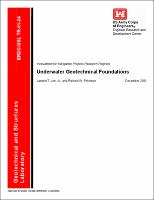Please use this identifier to cite or link to this item:
https://hdl.handle.net/11681/10534| Title: | Underwater geotechnical foundations |
| Authors: | Lee, Landris T. Peterson, Richard W. |
| Keywords: | Foundation engineering Underwater foundations Geotechnical engineering Underwater foundation construction Pile foundations Piling Underwater construction |
| Publisher: | Geotechnical and Structures Laboratory (U.S.) Engineer Research and Development Center (U.S.) |
| Description: | Technical Report Abstract: This report provides an overview and description of the design and construction of underwater geotechnical foundations and offers preliminary guidance based on past and current technology applications. Most of the state-of-the-art technology has been developed during 60 years of experience by the marine offshore industry solving complex foundation engineering challenges in the deep-ocean frontier, selected design firms and contractors, and, to a limited extent, local practice. Direct applications may or may not be made to site-specific underwater foundations in shallower rivers and inland waterways. However, most of the principles, techniques, and equipment are related. Case histories of selected in-the-wet (underwater) foundation projects are discussed for several types of structures: navigation, flood control, and dam structures; bridges; immersed tube tunnels and pipelines; offshore oil platform structures; and other underwater-founded structures. Three generalized underwater foundation types are described: improved-site, gravity-based, and pinned. Emphasis is placed on two of the most common pinned foundation types (piles and drilled shafts). Installation equipment and procedures are discussed, and differences between onshore and underwater foundation construction techniques are highlighted. Inspection and testing procedures are similar to those onshore, with the exception of pile load test frequency and methodologies. Underwater foundations constructed in-the-wet may allow a significantly beneficial alternative to the more expensive in-the-dry cofferdam construction, as experience is gained in applying this technology to the unique project needs of the U.S. Army Corps of Engineers. |
| Rights: | Approved for public release; distribution is unlimited. |
| URI: | http://hdl.handle.net/11681/10534 |
| Appears in Collections: | Technical Report |
